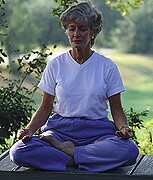 |
 |
 |

Many Cancer Patients Turn to Complementary Medicine
Women, especially breast and ovarian tumor patients, more likely to use these therapies|
|
HealthDay
Monday, August 4, 2008
 MONDAY, Aug. 4 (HealthDay News) -- As many as 61 percent of cancer patients use complementary therapies such as prayer, relaxation, meditation and massage, researchers from the American Cancer Society report.
MONDAY, Aug. 4 (HealthDay News) -- As many as 61 percent of cancer patients use complementary therapies such as prayer, relaxation, meditation and massage, researchers from the American Cancer Society report.
This new study echoes findings of other, smaller studies that also found that many cancer patients use complementary treatments. The kinds of methods used were influenced by sex, race, age, education, type of cancer and how far the disease has spread.
"Many complementary methods are extremely popular among cancer survivors, who are spending a lot of their time, money and attention on them," said study co-author Dr. Ted Gansler, the society's director of medical content. "For this reason, it is important to determine which are helpful, not only for shrinking tumors and extending survival, but also for relieving symptoms and improving quality of life."
For the study, published in the Sept. 1 issue of Cancer, Gansler's team collected data on 4,139 cancer survivors who participated in the American Cancer Society's Study of Cancer Survivors-I. The people were interviewed 10 to 24 months after diagnosis.
The use of some complementary methods by cancer survivors is very common, the study found. For example, 61.4 percent used prayer; 44.3 percent used relaxation techniques; 42.4 percent used faith/spiritual healing; 40.1 percent used nutritional supplements such as vitamins; 15 percent used meditation; 11.3 percent used religious counseling; 11.2 percent used massage; and 9.7 percent participated in support groups.
But other complementary methods aren't as common, the researchers found. Only 0.4 percent of survey participants used hypnosis; 1 percent used biofeedback therapy; and 1.2 percent used acupressure or acupuncture.
All types of complementary methods were more popular among women, Gansler said. Fifty-nine percent of women and 43 percent of men turned to methods such as aromatherapy, art therapy, support groups, hypnosis, imagery/visualization, meditation and relaxation.
And methods such as tai chi and yoga were used by 10.1 percent of women, compared with 1.9 percent of men. Massage was used by 16.6 percent of women, but only 3.9 percent of men, the study found.
"In general, younger, more educated and more affluent cancer survivors were more likely to use complementary methods," Gansler said. "People with more advanced cancer were more likely to be complementary-method users."
And, complementary methods are much more popular among breast and ovarian cancer survivors, Gansler said.
"This is not only because ovarian cancer is obviously limited to women and breast cancer is extremely rare among men. For example, all types of complementary methods were used more often by breast and ovarian cancer survivors than by uterine cancer survivors -- also women, of course," he said.
It's not clear why complementary methods are used more often by women with breast and ovarian cancer, Gansler added.
It's also not clear just how much benefit complementary therapies might confer, he said. "Scientific studies of complementary methods have become much more common during the past few years, but there is still a lot of uncertainty about the effectiveness of many complementary methods," he added.
"As more studies are done to evaluate effectiveness, we will want to know whether men are missing opportunities to use some effective complementary methods that are far more popular in women, or whether women use ineffective complementary methods more than men. Or whether some complementary methods are more effective for women than they are for men," Gansler said.
Alternative medicine expert Dr. Harold Burstein, an instructor in the Department of Medicine at Harvard Medical School, said, "This study, like many before it, confirms that cancer patients actively pursue a variety of alternative and complementary therapies, usually in conjunction with standard approaches to cancer treatment."
The motivations for such practices are worth exploring, Burstein said. "It is not known, but it is not thought that these have an impact on cancer-related outcomes, though many patients report deriving comfort, solace or symptom relief with such practices," he said.
HealthDay
Copyright (c) 2008 ScoutNews, LLC. All rights reserved.
More News on this Date
Related MedlinePlus Pages:
| Home | Health Topics | Drugs & Supplements | Encyclopedia | Dictionary | News | Directories | Other Resources | |
| Disclaimers | Copyright | Privacy | Accessibility | Quality Guidelines U.S. National Library of Medicine, 8600 Rockville Pike, Bethesda, MD 20894 National Institutes of Health | Department of Health & Human Services |
Date last updated: 05 August 2008 |




